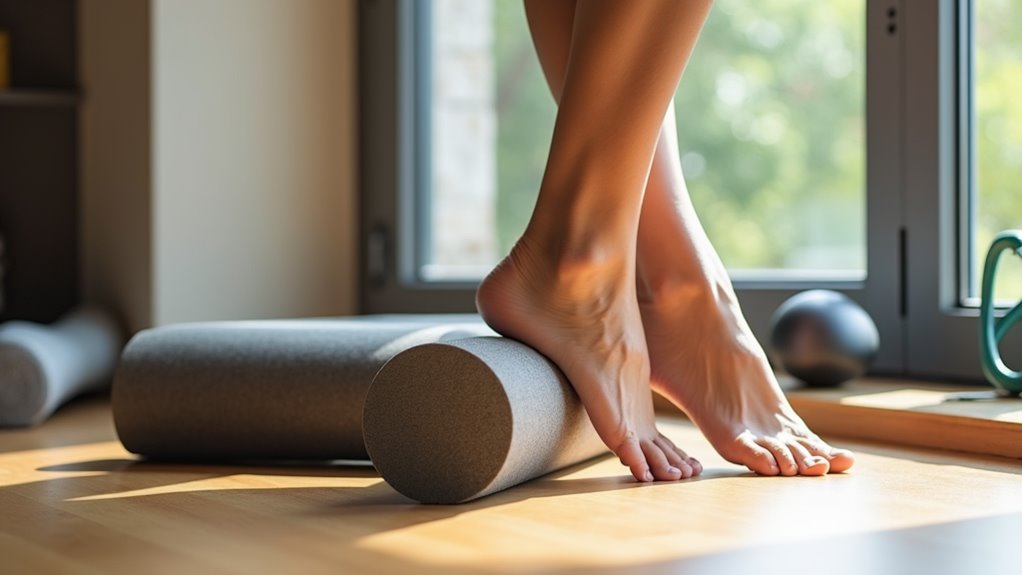There may be products. Products are independently selected by our editors. We may earn an affiliate commission from the links with no charge to you, example: as Amazon Affiliate.
Like a tightrope walker balancing on a steel thread, you’ve mastered the art of striding confidently in your favorite heels. Yet, those glamorous shoes can take a toll on your feet, ankles, and entire body alignment. You’ll need more than just a foot soak to counteract the effects of prolonged heel wear, as the impact reaches from your toes to your lower back. Whether you’re a daily heel wearer or occasional stiletto enthusiast, understanding proper recovery techniques can mean the difference between lasting damage and maintaining the freedom to choose any shoes you desire.
Key Takeaways
- Perform daily stretches focusing on the Achilles tendon and calf muscles to maintain flexibility and prevent muscle shortening.
- Practice intrinsic muscle stretches by holding between toes for 30 seconds, repeating 10 times for optimal foot recovery.
- Progress from double-leg to single-leg heel raises to build ankle stability and strengthen foot muscles.
- Combine ankle circles, toe-tapping, and resistance band exercises for comprehensive foot flexibility and strength improvement.
- Utilize recovery tools like foot rollers and massagers while incorporating regular warm water soaks with Epsom salts.
Understanding High Heel Pain
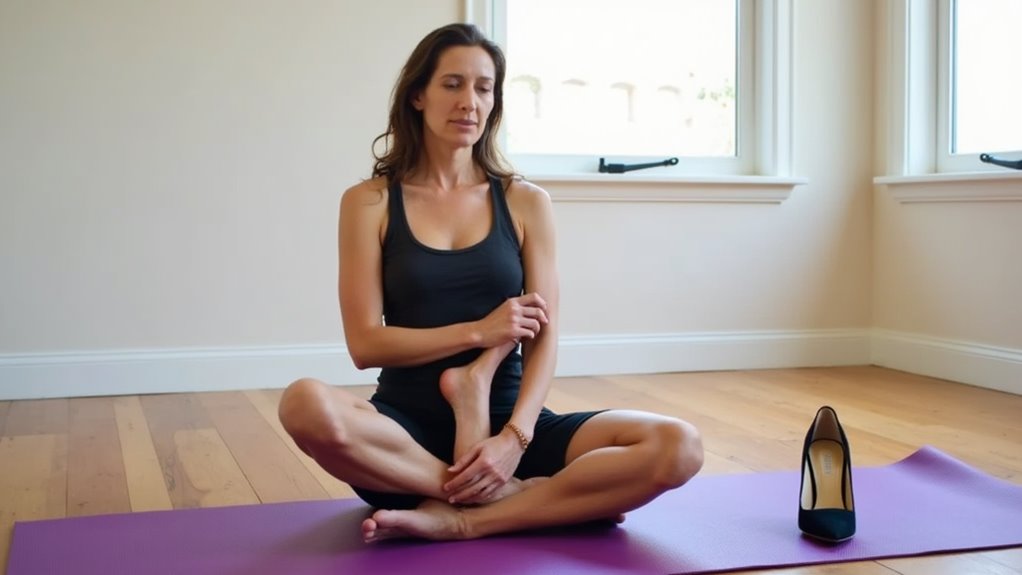
When you wear high heels regularly, you’re putting your feet at risk for various types of heel pain. The most common issue you’ll face is plantar fasciitis, which causes sharp, stabbing pain under your heel, especially during your first steps in the morning.
You might also develop heel spurs, calcium deposits that form where your fascia connects to the heel bone.
Your walking style changes dramatically in high heels, which can lead to abnormal gait patterns and increased pressure on your heel area.
This pressure often results in swelling, tenderness, and sometimes even stone bruises from the repeated impact.
If you notice redness, thickening of the skin behind your heel, or inconsistent pain patterns, you might be experiencing retrocalcaneal bursitis or Achilles tendinosis.
For more comfortable alternatives, consider Irish-inspired footwear that combines style with traditional comfort features.
The Science Behind Heel Damage
The harmful effects of high heels on your body go far beyond simple discomfort. When you wear high heels, you’re forcing your foot-ankle complex into an unnatural position that triggers a chain reaction throughout your entire lower body.
Your muscles become imbalanced – some strengthen while others weaken – leading to ankle instability and altered posture.
You’ll notice significant changes in how you walk, as your gait becomes less fluid and natural. Over time, this can result in shortened calf muscles, weakened ankles, and increased stress on your knees and lower back.
The pressure points created by high heels can damage ligaments and nerves, potentially contributing to chronic conditions like osteoarthritis, plantar fasciitis, and persistent lower back pain.
Even more concerning, you’re at higher risk for injuries and developing painful bunions.
Essential Prevention Strategies
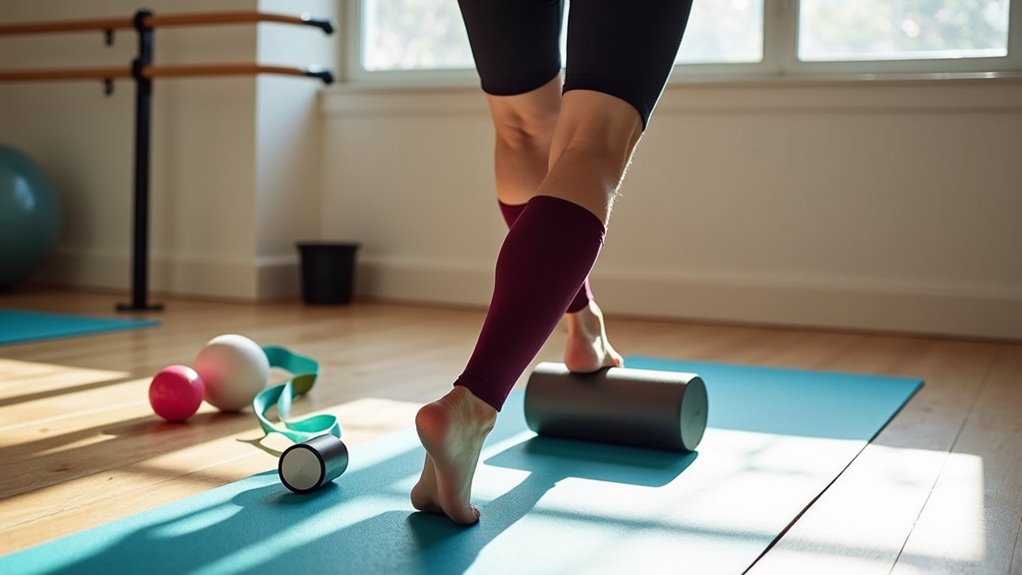
You’ll prevent most heel-related foot problems by selecting heels between 2-3 inches and opting for chunky styles or wedges that distribute weight more evenly.
Your daily stretching routine should focus on the Achilles tendon and calf muscles, incorporating exercises like toe yoga and ankle circles to maintain foot strength.
When you’re not wearing heels, switch to supportive footwear like loafers or sneakers to give your feet proper recovery time.
For maximum comfort throughout the day, choose heels with cushioned support systems that minimize pressure points and fatigue.
Proper Heel Height Selection
Selecting proper heel height plays a pivotal role in preventing foot-related injuries and discomfort. You’ll want to assess your foot’s anatomy, particularly your talus bone flexibility, to determine the ideal height for your shoes. Consider measuring the distance from your ankle to your toes for a height that matches your body’s proportions.
| Height Range | Best For | Considerations |
|---|---|---|
| 1-2 inches | Daily wear | Ideal for active lifestyles |
| 2-3 inches | Work/Events | Requires arch support |
| 3-4 inches | Special occasions | Limited walking time |
| 4-5 inches | Brief wear | Need ankle straps |
| 5+ inches | Not recommended | Risk of injury |
Remember that your lifestyle and comfort tolerance should guide your choice. Opt for heels with wider bases and built-in arch support, and don’t exceed 3 inches for regular wear to protect your foot health.
Daily Stretching Routine
Regular stretching serves as a vital defense against the strain of wearing high heels, helping to prevent common foot problems and maintain flexibility.
You’ll want to start with the intrinsic muscles stretch by sliding your fingers between your toes, holding for 30 seconds, then gently pulling your toes downward for 5 seconds, repeating 10 times.
For ankle mobility, perform ankle circles in both directions, completing 10 rotations each way.
Don’t forget the standing adductor stretch to improve your balance and strengthen your legs. Stand hip-width apart, bend one knee while reaching for your ankle, and hold for 15-20 seconds per side.
After wearing heels, soak your feet in warm water with Epsom salts and use toe spacers for relief.
Remember to stretch your Achilles tendon and calves, holding each position for 30 seconds.
Choose Supportive Footwear Style
When choosing high heels, prioritizing support and comfort can significantly reduce the risk of foot-related problems.
Opt for heels no higher than 2-3 inches and favor chunky heels or wedges over thin stilettos for better stability. Look for shoes with wide, almond-shaped toe boxes that allow your toes to spread naturally.
Select footwear made from soft, flexible materials like leather or suede that’ll conform to your feet.
Ensure they’re equipped with cushioned insoles and proper arch support. You’ll want removable insoles if you use custom orthotics.
Don’t forget about breathability – materials that allow air circulation will prevent moisture buildup and discomfort.
Consider brands like Cobb Hill, Olukai, or Vionic that specialize in health-conscious designs, and always ensure your shoes fit properly to avoid blisters and instability.
Daily Stretches for Recovery
To maximize recovery after wearing high heels, incorporating specific daily stretches can significantly reduce discomfort and prevent long-term foot problems. Focus on calf stretches by standing facing a wall, placing one foot forward and leaning in while keeping your back leg straight. You’ll want to hold this position for 20-30 seconds. Consider creating a Southern European inspired relaxation space where you can comfortably perform your recovery stretches.
| Exercise | Duration |
|---|---|
| Wall Calf Stretch | 30 seconds |
| Towel Pull | 30 seconds |
| Heel Raises | 2 sets of 15 |
Don’t forget to roll your feet over a water bottle or tennis ball to release plantar fascia tension. Practice ankle mobility by drawing the alphabet with your toes while seated. For the best results, elevate your feet after these exercises and apply ice if you’re experiencing any inflammation.
Building Ankle Strength
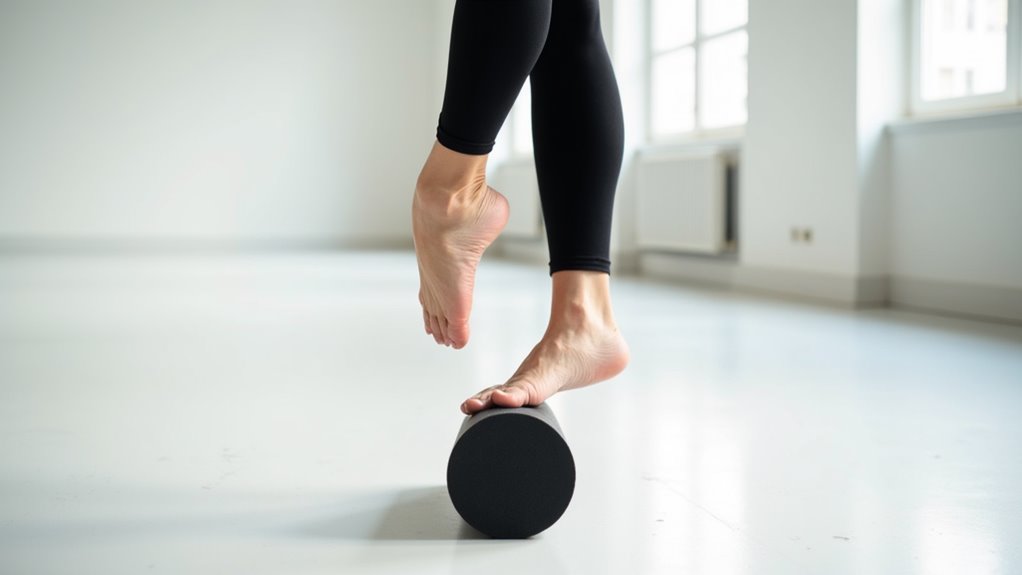
Strong ankles serve as the foundation for comfortable high heel wear, and you’ll need more than basic stretches to build this essential strength.
Start with basic heel raises to strengthen your calf muscles, progressing from two-leg to single-leg variations as you build stability.
Incorporate ankle circles and rolls in both directions to improve flexibility and combat tendonitis. You can intensify your routine by adding resistance bands or weights during seated calf raises.
For advanced development, try exercises on a slant board or step to increase range of motion.
Don’t forget to include toe-tapping exercises to enhance circulation and flexibility in your feet.
As you progress, add dynamic movements like rebound jumps and plyometric exercises to develop explosive strength, which will help prevent fatigue when wearing heels.
Balance Training Exercises
Because high heels alter your natural balance, mastering stability exercises will help protect you from potential injuries.
Start by practicing single-leg stands for 30 seconds on each side while keeping a stable object nearby for safety. Once you’re comfortable, challenge yourself by standing on a folded yoga mat or balance pad.
Progress to heel raises and calf lifts, focusing on controlled movements that strengthen your ankle muscles.
You’ll notice improved stability when you add dynamic exercises like the “4 Square Jump” and rotational movements in different directions. Try closing your eyes during basic balance poses to enhance your proprioception.
Remember to listen to your body and advance gradually. Regular practice of these exercises will help you maintain better stability, especially when transitioning between heels and flat shoes.
Professional Treatment Options
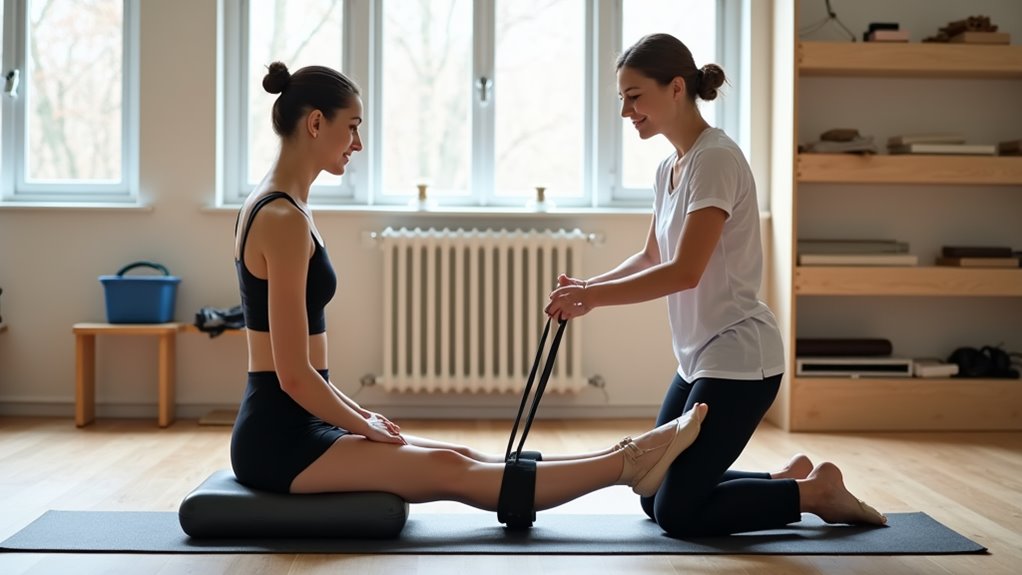
While many high heel-related foot issues can be managed with at-home exercises, persistent pain or chronic conditions may require professional intervention. Your doctor might recommend non-surgical treatments like laser or shockwave therapy, which use targeted energy to stimulate natural healing and reduce pain. For severe cases, surgical options such as flat foot or high arch correction may be necessary.
| Treatment Type | Options | Recovery Time |
|---|---|---|
| Non-Surgical | Laser Therapy, EPAT | Immediate to Several Weeks |
| Minimally Invasive | HyProCure, Aquaroll | 2-6 Weeks |
| Surgical | Flat Foot Surgery, High Arch Correction | Up to 1 Year |
Your podiatrist can determine the most appropriate treatment based on your specific condition, considering factors like severity, lifestyle, and recovery expectations. Many treatments can be combined with custom orthotics for optimal results.
Recovery Equipment and Tools
To complement professional treatments, a range of specialized recovery tools can help you maintain foot health and prevent high heel-related injuries at home.
The HighHealer 5-in-1 Foot Therapy Tool offers comprehensive exercises, while TheraBand’s foot roller provides soothing relief when frozen.
For targeted recovery, you’ll find TheraBand resistance bands useful for foot strengthening exercises, particularly the Foot Intrinsic Flat Exercise.
The Roller Massager+ effectively mobilizes tight calf muscles, especially beneficial for those experiencing fibrotic issues.
If you’re looking to improve overall leg strength, consider leg exercise machines with adjustable resistance levels.
These tools, combined with stability trainers for balance exercises and specialized calf strengtheners like the LilaExogen sleeves, create a complete at-home recovery system for high heel-related discomfort.
Long Term Health Considerations
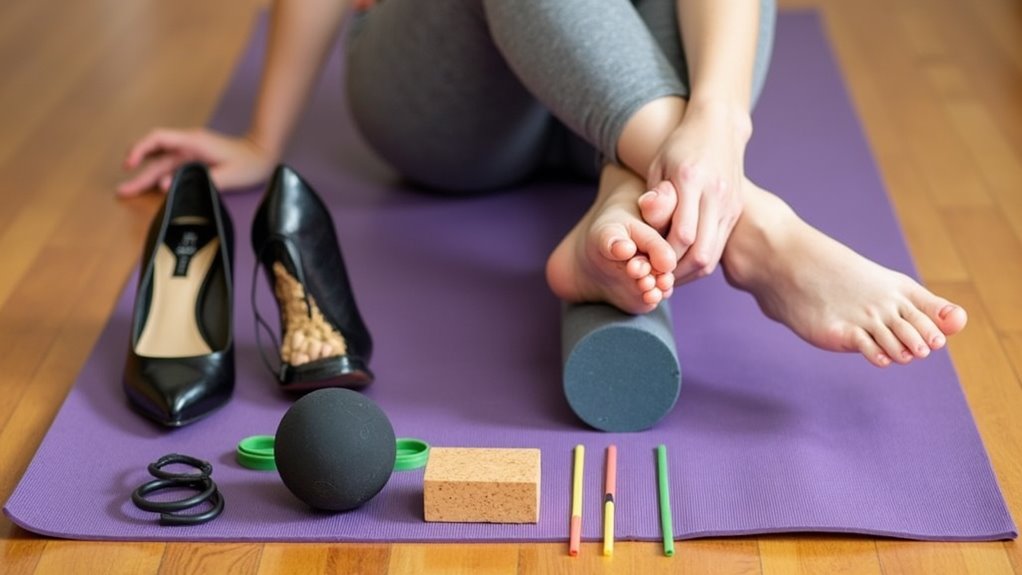
Although high heels can elevate your style, their long-term effects on your body shouldn’t be ignored. Prolonged heel wear can trigger a cascade of musculoskeletal issues, from chronic back pain to joint problems in your hips and knees.
Your feet bear the brunt of these changes, with conditions like metatarsalgia, bunions, and hammertoes becoming more likely over time.
You’ll also need to consider how high heels affect your overall mobility. The altered ankle alignment and gait patterns you develop can increase your injury risk, even when you’re wearing flat shoes.
To protect your long-term health, limit heel height to two inches, incorporate regular stretching exercises, and strengthen your hip and gluteal muscles. Consider using custom shoe inserts to maintain proper foot support and alignment. For immediate relief after wearing heels, switching to comfort pumps can help minimize foot strain while maintaining a professional appearance.
Creating Your Recovery Plan
You’ll need a structured daily exercise schedule that combines immediate post-heel recovery techniques with strengthening exercises to effectively bounce back from high heel wear.
Track your progress by noting improvements in flexibility, reduced pain levels, and increased duration of comfortable heel wear time.
Set achievable recovery goals like mastering basic stretches within the first week, progressing to advanced exercises by week three, and maintaining a consistent routine that prevents future discomfort.
Daily Exercise Schedule Breakdown
Creating an effective recovery plan starts with organizing the exercises into a structured daily routine that targets different aspects of foot health.
Start your morning with 5 minutes of ankle rolls and heel cord stretches to warm up tight muscles.
During lunch breaks, perform towel stretches and theraband exercises to maintain flexibility and build strength.
When you’re back home, dedicate 10 minutes to balance exercises like single-leg stands and heel walks.
Before bed, focus on recovery with gentle stretching and pick-up exercises using small objects.
Remember to alternate between strengthening and stretching days to prevent overuse.
You’ll want to incorporate rest periods, especially on days you’ve worn heels.
Stay consistent with this routine while maintaining proper hydration and nutrition for optimal results.
Tracking Progress Through Recovery
To effectively monitor your heel recovery journey, maintaining detailed progress records is essential. Start by tracking your heel raise progressions, documenting the amount of force and load you can handle during each session.
As you improve, you’ll gradually shift from partial weight-bearing exercises to single-leg heel raises.
Keep a log of your sprinting technique improvements, particularly focusing on wall drills and high heel recovery movements. Document your progress through exercise variations, from basic marching drills to more advanced flying runs and knee drives.
Pay special attention to your biomechanical efficiency and form during these exercises.
Monitor your rehabilitation milestones carefully, noting any pain or discomfort. You’ll want to ensure you’re following progressive overload principles while preventing re-injury through proper ankle strengthening and careful attention to form.
Setting Realistic Recovery Goals
Building on your progress tracking system, it’s time to establish clear recovery goals that align with your healing timeline. You’ll want to create specific, measurable objectives that break down your recovery journey into manageable steps.
- Set realistic timeframes for increasing heel height and wear duration
- Define weekly targets for foot strengthening exercises
- Track comfort levels and adjust goals based on your body’s response
Your recovery plan should prioritize rest periods while gradually building endurance.
Focus on incremental improvements rather than rushing the process – this means listening to your body and adjusting your goals accordingly. Remember to incorporate mindfulness techniques to stay aware of any discomfort, and celebrate small victories as you progress toward your ultimate recovery goals.
Conclusion
You’ve learned the tools to protect your feet from high heel strain, and it’s no coincidence that these recovery techniques mirror dancers’ warm-up routines. Whether you’re stretching your calves after a night out or building ankle strength during lunch breaks, you’re now equipped to balance fashion with foot health. Remember, your feet carry you through life – treat them well, and they’ll keep you dancing.

